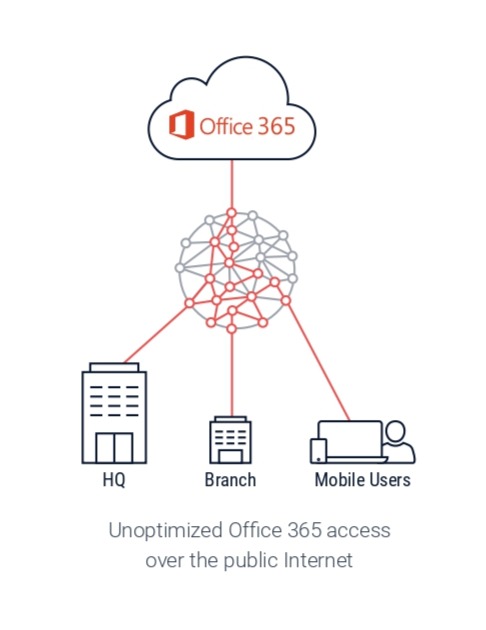Migration to office 356 impacts your network design
Many enterprises are taking advantage of Microsoft Office 365. Moving to Office 365 reduces the load on IT to deploy, maintain, and secure Microsoft Office components, such as Sharepoint and Exchange. Instead, the company uses an Office 365 instance in a specific geographical location. The move to the cloud means that network traffic patterns are going to change dramatically. Mobile users and branch locations can’t benefit from traditional network optimization tools for branch-to-datacenter connectivity. With Office 365, traffic needs to be optimized for global access to a specific geographic location to maintain consistent application experience.
Cato Cloud optimizes global access to Office 365
Cato deployed a global network of Points of Presence (PoPs) that are fully meshed across SLA-backed global carriers – the Cato Cloud Network. Remote branches and mobile users connect to the nearest available Cato PoP via secure tunnels. The Cato PoPs run proprietary software that accelerates traffic from all enterprise locations and mobile users to both the datacenter and cloud applications, such as Office 365. When a user accesses Office 365, traffic goes through the tunnel and into the PoP, typically 25ms away. It is then sent through the best performing route within the Cato Cloud Network to the PoP closest to the Office 365 instance. Often, the PoP shares the network or datacenter of the Office 365 instance.

Cato Office 365 access optimizations Cato applies multiple optimization techniques to achieve 10x-30x improvement in end-to-end throughput:
Multi-segment optimization Cato breaks the end-to-end connection into three parts: User-to-PoP, PoP-to-PoP and PoP-to-Office 365. This split allows Cato to detect packet loss at the PoPs and quickly recover, which is far faster than waiting for a response from the distant destination.
Optimal path selection Cato continuously monitors the latency and packet loss on the various providers that underpin the Cato Cloud Network. The optimal route for Office 365 traffic is calculated per-packet to minimize global latency and packet loss.
Active/active link aggregation Cato leverages multiple last-mile links to maximize bandwidth into the Cato Cloud Network. Forward error correction (FEC) Cato dynamically activates FEC on both the last mile and the cloud network to eliminate packet loss.

Contact Us for more information about CATO.
*Averett Pte Ltd is a certified reseller of CATO Networks and all information regarding CATO Networks products and services published on our site are republished from CATO Networks.




